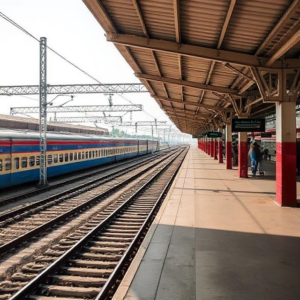The design and architecture of railway stations play an important role in providing comfort, efficiency, and a pleasant experience for passengers. In India, railway stations vary in design based on location, purpose, and size, but all have some common features to meet the needs of travelers. Here’s an easy-to-understand breakdown of how railway stations are designed and built:
1. Overall Layout:
- Platform: The platform is where passengers wait for trains. It’s usually a long, wide area that runs parallel to the train tracks. Stations can have multiple platforms, with larger stations having several.
- Tracks: The tracks are the pathways for trains. They are placed alongside the platform, and stations are designed so that trains can stop at different platforms.
- Entry and Exit Points: Stations have well-planned entry and exit points to ensure smooth movement of passengers, with wide gates and pathways for ease of access.

2. Passenger Facilities:
- Ticketing Area: Most stations have ticket counters where passengers can buy tickets. Larger stations have automated ticket machines for quicker service.
- Waiting Areas: Comfortable waiting areas with seating arrangements are available for passengers who are waiting for their trains. Some stations have separate waiting areas for men, women, and senior citizens.
- Restrooms: Clean and hygienic restrooms are provided at stations for passengers.
- Food and Refreshments: Stations often have food stalls, restaurants, or cafeterias to provide refreshments.
- Shops: Many stations have shops selling newspapers, magazines, snacks, and other travel essentials.
3. Design Features:
- Modern Architecture: Big stations have modern designs with glass facades, beautiful interiors, and spacious halls. They also use eco-friendly materials and designs for sustainability.
- Traditional Architecture: Some historic or older stations may have traditional designs, influenced by local culture or colonial architecture, with large domes, arches, and decorative elements.
- Safety Features: Stations are designed to ensure passenger safety, with clear signage, emergency exits, CCTV cameras, and fire exits.
- Accessibility: Designs are made accessible for differently-abled passengers, with ramps, elevators, and designated spaces for wheelchairs.
4. Train Movement and Operations:
- Signal Systems: Railway stations are equipped with complex signaling systems to ensure safe and smooth train operations. These signals help in controlling the movement of trains and preventing accidents.
- Control Room: Each station has a control room where railway staff monitor train arrivals and departures, manage traffic, and ensure safety.
- Waiting Room and Ticket Booking Systems: At larger stations, automatic ticketing systems and digital displays help passengers know train timings and platform information.
5. Sustainability in Station Design:
- Green Stations: Many modern stations focus on sustainability by using solar power, rainwater harvesting, and energy-efficient lighting. These efforts reduce the carbon footprint of the stations.
- Landscaping: Many stations have gardens or green spaces where passengers can relax and enjoy a more pleasant environment.
6. Station Aesthetics and Ambience:
- Lighting: Good lighting is important in stations for safety and visibility. Bright, well-placed lights make the environment feel welcoming, while also helping passengers navigate the area.
- Decor and Artwork: Some stations feature artwork or murals that reflect the culture, history, or local traditions. This adds to the aesthetic appeal of the station and makes it a more pleasant place to be.
7. Innovations in Station Architecture:
- Smart Stations: Some of the modern stations are referred to as “smart stations.” They include features like Wi-Fi, mobile charging stations, smart ticketing systems, and digital information displays.
- Connectivity: Many stations are designed with better connectivity to other transportation options like buses, metros, and taxis, making it easier for passengers to travel.
8. Major Railway Station Examples:
- New Delhi Railway Station: A major hub with modern facilities, large waiting areas, and high-tech features like automated ticketing.
- Chhatrapati Shivaji Maharaj Terminus (Mumbai): Known for its colonial architecture with beautiful arches, domes, and intricate designs.
- Kochi Metro Station: A great example of a modern design focusing on eco-friendly features, cleanliness, and passenger convenience.
Conclusion:
The design and architecture of railway stations are carefully planned to ensure they meet the needs of passengers, provide a safe and comfortable environment, and allow smooth train operations. Whether it’s a modern station with high-tech features or a historic station with traditional designs, each station plays a vital role in making train travel a seamless experience for millions of people every day.
Keywords: Indian Railway, Railway











